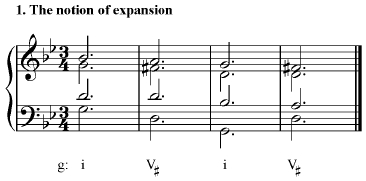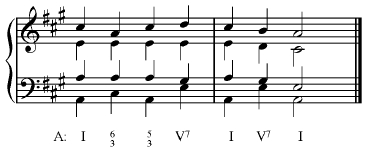Aldwell-Schachter Chapter 8
Click the musical examples for playback
We begin with an incredibly simple progression — just tonic and dominant. The technique called expansion can be used to make this progression more interesting.
Without actually changing the chords in any way, some chordal skips, or arpeggiations, are added in both the soprano and tenor voice. (The changes in the tenor voice are necessary to compensate for the loss of the third of the chord when the soprano moves from third to fifth. The soprano and tenor are involved in a voice exchange in swapping the third and fifth of the chord.)
By moving the bass from root of the chord to third of the chord, the inversion of the chords on the second beat measures 1 & 3 has been changed: the tonic triad in root position becomes a first-inversion chord. The root-position tonic triad has therefore been expanded by its own first inversion, by the use of a chordal skip in the bass.
In this last modification the dominant chord in the second measure becomes its own first inversion, thereby allowing for a much more interesting bass line. Note also that the example has begun on a first-inversion tonic triad instead of a root-position triad. Also note the leap in the bass (down a sixth) in the third measure. Overall this remains a simple tonic-dominant progression, but it has become much more interesting due to the use of expansion.
I6/3 creates a fine expansion of a root-position tonic. The soprano moves in parallel motion to the bass in this example.
In this example, the soprano moves in contrary motion to the bass, creating what is called a voice exchange between soprano and bass. Other motions are possible — see the section in the textbook on "6/3 expanding 5/3" (page 99 in the third edition) for more examples.
V6/3 expands V much in the same manner as I6/3 expands I. One must be a bit careful in writing a V6/3 not to double the bass note, which is the leading tone.
A very common use of V6/3 is as lower neighbor to I, thus expanding the tonic. In this example, the lower neighbor tone is complete. This example is in the minor and demonstrates that, while it is necessary to raise the leading tone in the bass, there is no way to indicate this in the figures. Remember that the arabic numerals indicate intervals above the bass and therefore cannot indicate any changes of the bass note itself.
In this example, an incomplete lower neighbor is used as an expansion of I, creating a very interesting leap of a diminished fourth in the bass, which is then properly resolved.
vii6/3, the first inversion of the leading-tone triad, is a diminished triad in first inversion. Its sonority is nearly rootless and as such the chord does not stand on its own. It is almost always encountered as a connective chord between I and I6/3. In this example, the chord is constructed via a voice exchange in the outer voices—probably the most common construction. Voice leading: find a contrary motion (in this case in the outer voices) and the rest will almost certainly go smoothly. The motion from the diminished fifth in the inner voices in the vii6/3 to the perfect fifth in the I6/3 is perfectly acceptable, and actually unavoidable in most constructions involving the vii6/3. Always remember to indicate that the chord is diminished in your figures!

This example shows a vii6/3 being constructed with parallel motion in the outer voices. Again note the diminished fifth in the vii6/3 moving to a perfect fifth in the I6/3; this is normal voice leading in such a situation. Also note the contrary motion between the two lower voices; good voice leading involving the vii6/3 generally begins with finding a voice exchange and then allowing the other voices to 'fall' around that voice exchange.

This looks fancier than it is: all that's happening is an incomplete lower neighbor in the soprano which produces the intriguing diminished fourth in the soprano. Note that the usual contrary motion is present in the lower voices.
Also worth of note is the analysis. In minor keys, the sixth of the vii6/3, being the leading tone of the key, is raised. In figures, it is traditional to indicate a raised sixth by drawing a slash through the "6" in the arabic numerals. Using an accidentals would be perfectly acceptable, but the slash is the customary notation.
Here's an incomplete upper neighbor in the soprano, allowing for an interesting leap of a perfect fourth in the soprano. Note that in this example the leap has been treated sequentially by copying it a step higher in the second measure, and harmonizing it with a dominant.












